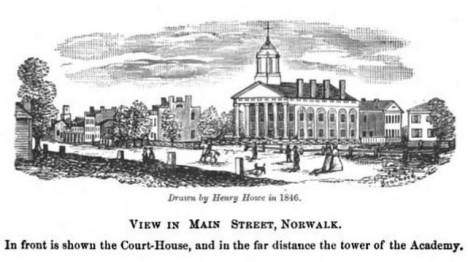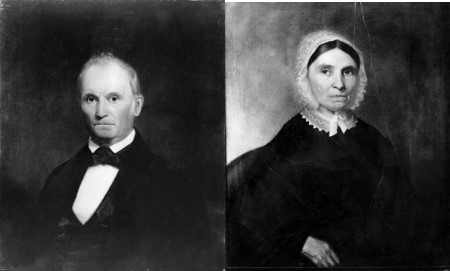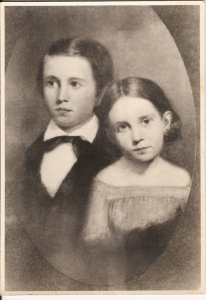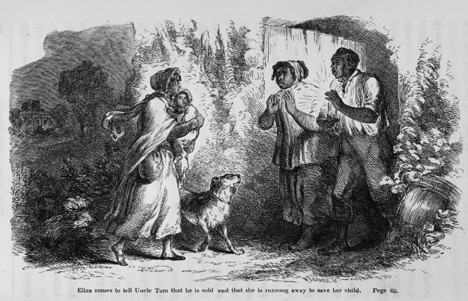Sufferers’ Land
Norwalk, Ohio Life in the 1850’s
by Dave Barton
A new generation was growing up in Norwalk in the early 1850s, the offspring of the young people who had come to Norwalk with their parents in the 1820s. The Gallup, Wickham and Benedict children played together and with the other youngsters of the town. Boys and girls gathered at each other’s homes for parties where they played “kissing” and other games and enjoyed treats such as homemade ice cream.
The whole town was a playground for these children. They played “hide and seek” and other games around the distillery on the south side of Norwalk Creek, with its long rows of whiskey barrels and herds of cattle fattened on “slop” left over from the distilling process. In warm weather, they burrowed in the sand banks along the creek, sometimes digging so far that a “cave-in” would bury them. Winters, they sledded down the banks and skated on the frozen creek. [1]
In 1850, when the population of Norwalk reached about two-thousand, public schools opened in the village. Previously, a welter of private schools and the Norwalk Academy had met the educational needs of the community, but now public schools would provide a common experience for children. [2]
One public school teacher was Mary Janes, who boarded in the home of Mrs. John Vredenburg. Her roommate was Matilda Barrett, who afterwards married Charles A. Preston, Lucy Wickham’s brother, after the death of his first wife. In later years, Mary remembered the students she taught in those carefree days.
At twenty years of age, I was an assistant to the popular principal of the Norwalk Grammar School, Col. D. F. DeWolf. Hon. and Mrs. S. T. Worcester were really godfather and mother to this charming department in whose genial atmosphere the youth of the Village blossomed, shedding fragrance in all homes. There were Martha Worcester and Kate Wickham, Fanny Safford, Spencer Leslie, Vick McArdle and Augusta Carter, delightful Tina and Delilah Yale, Emma Wildman, Fanny Clark, Emma Husted, Mary J. Graves, Milo Cline, Lutheria Eichert, Caleb and Lizzie Gallup, Will Perkins, whom I recall as a specially lovely boy, and the Wickham brothers, with a host besides. I feel the thrill yet, experienced while the “Merchant of Venice” was acted by our amateurs, Charlie Wickham as “Shylock” and Emma Husted as “Portia”.
Can I cease to remember any of the carefree, laughing youth who trooped in the schoolrooms, all so bright, ambitious and diligent? Don’t I know how Delilah Yale came to my desk asking if she might go home, as it rained so that morning she forgot her slate pencil? Didn’t “Caley” Gallup take a very few of us out one evening to witness a séance when spirit rapping was a curiosity? Lizzie Gallup entertained me often over at her house, the hospitable board being presided over by her grandfather, Platt Benedict. [3]
One of Mary Janes’s students was Emily Wildman, known as Emma. She came to Norwalk from Clarksfield Township in 1852 when her father Frederick Wildman was elected to the office of Clerk of Courts for Huron County and moved his family into town. [4] She was a serious girl, with a piercing gaze.
Emma’s best friend was Kate Wickham who was the same age as Emma. Emma’s sister Mary Wildman, who was seven years old, became good friends with Kate’s sister Mary Wickham. The four girls spent much of their time visiting each other’s homes, often eating dinner together. Emma caught the attention of Kate’s brother Charlie, and they became sweethearts. [5]
Another of Emma’s friends was Lizzie Gallup, the youngest daughter of Hallet and Clarissa Gallup and granddaughter of Platt Benedict. She was born in her grandfather’s house on April 1, 1837, and spent much of her time there. [6]

Fanny Benedict
A “Queen Bee” among the handsome girls was Lucy Preston, daughter of Lucy Wickham’s brother Charles Preston and his first wife. She was very intelligent and had an attractive personality. [7]
The most beautiful of the girls in Norwalk at that time was Fanny Benedict, Dave Benedict’s sister. She was a pure blonde in complexion; her features were a classic, her movement’s grace, her character an inspiration. She was considered the undisputed belle of the town. [8]
These girls had a carefree life in the early 1850s. They attended school together, gathered at each other’s homes and went to parties and balls with the boys of the village. Little did they know that in a few short years, this charmed life would end, and the boys they knew and loved would march off to war, leaving them to cope with the deprivations and uncertainties of life on the home-front.
Footnotes:
[1] Description of life in Norwalk from 1840-1850 is from “Norwalk, Its Men and Women, and Some of the Girls I have Met,” by William Wickham, The Firelands Pioneer, New Series, Volume XX; The Firelands Historical Society; December 1918, pp. 2073-2077.
[2] “The Maple City,” by P.J. Mahon, The Firelands Pioneer, Old Series, Volume XIII; The Firelands Historical Society; July, 1878, p. 90.
[3] Reminiscences of a school teacher in 1851 Norwalk from “Pioneer Girlhood on the Firelands,” by Mrs. Mary B. Ingham, The Firelands Pioneer, New Series, Volume XIII; The Firelands Historical Society; December 1900, p. 621.
[4] From Obituaries – The Fireland Pioneer, New Series, Volume XXI; The Firelands Historical Society; January 1920, p. 2486.
[5] The friendships of the Wickham and Wildman girls is described in “Norwalk, Its Men, Women and Girls,” by William Wickham, The Firelands Pioneer, December 1918, p. 2097 & p. 2143.
[6] From Obituaries – The Fireland Pioneer, January 1920, pp. 2451-2.
[7] From “Norwalk, Its Men, Women and Girls,” by William Wickham, The Firelands Pioneer, New Series, Volume XX; The Firelands Historical Society; December 1918, p. 2085.
[8] From “Norwalk, Its Men, Women and Girls,” by William Wickham, The Firelands Pioneer, New Series, Volume XX; The Firelands Historical Society; December 1918, p. 2105.
The image of Fanny Benedict is from the collection of my cousin Susan Orsini.
#
This post was first published on this blog in 2009.
#
Previous Post: End of an Era
Next Post: Railroads and Cholera
#
Thanks for visiting! Share and like this post below, and on Facebook. Let me know what you think in the comments. I’d love to hear from you!
Filed under: Benedict, Gallup, Norwalk, Ohio, Ohio, Uncategorized, Wickham | Tagged: Benedict Genealogy, Caleb Gallup, Fanny Benedict, Firelands History, Gallup Genealogy, Norwalk Ohio 1850s, Norwalk Ohio History, Ohio History, Platt Benedict, Sufferers' Land History, Wickham Genealogy | 8 Comments »






